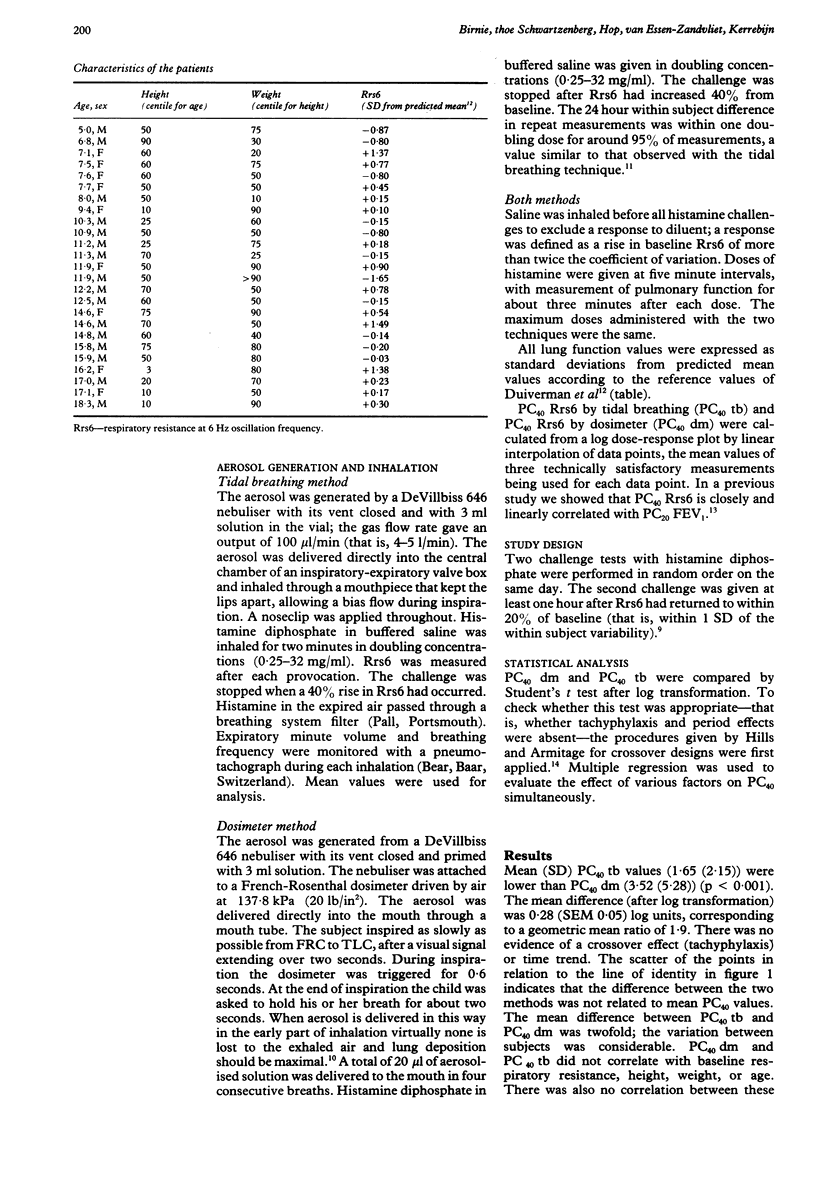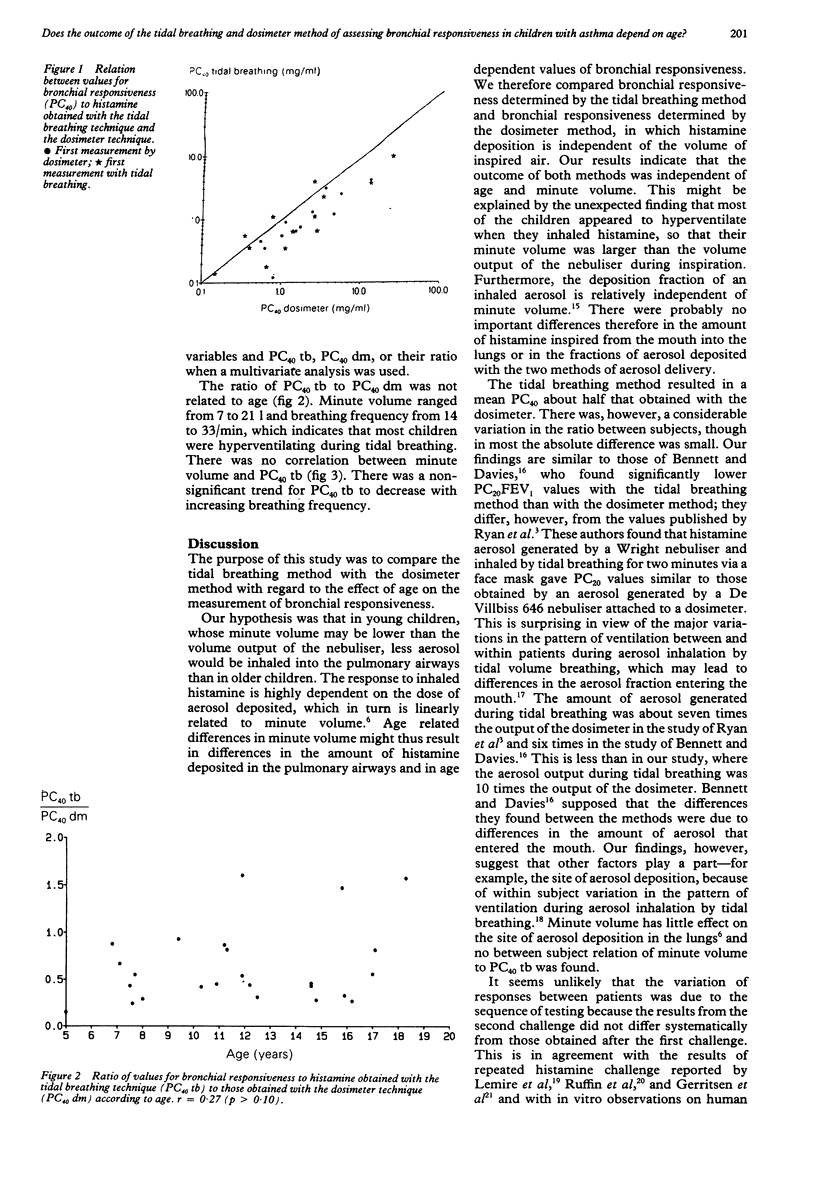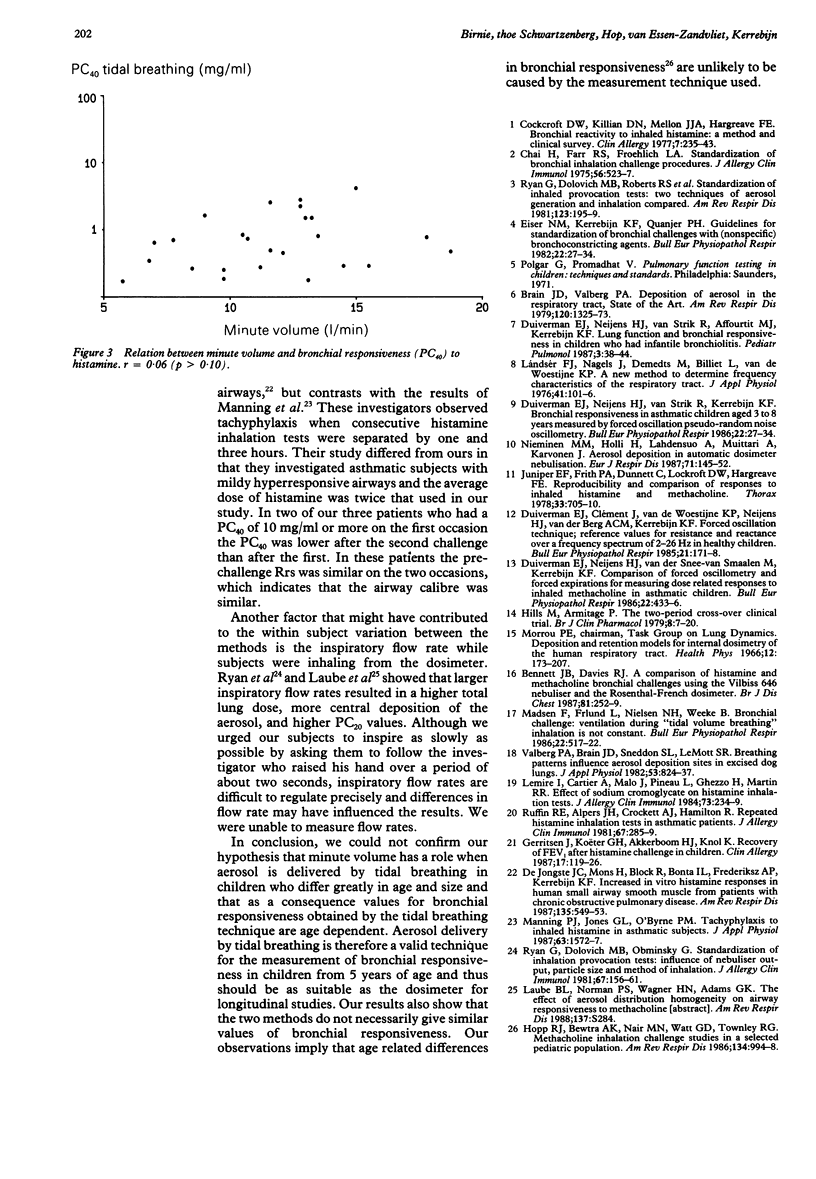Abstract
As minute volume increases with age, a study was carried out to determine whether the measurement of bronchial responsiveness to pharmacological agents with the tidal breathing technique in children might be influenced by age. Bronchial responsiveness to histamine administered by tidal breathing was therefore compared with that produced with a dosimeter in 25 children with asthma aged 5-18 years. Bronchial responsiveness was defined as the concentration of histamine that caused a 40% rise in pulmonary resistance (PC40) measured by random noise forced oscillation at 6 Hz. Values of PC40 measured by the tidal breathing method were lower than those obtained with the dosimeter method, presumably owing to differences in the dose administered and variations in the pattern of breathing. The difference between the two methods was not related to age, however. It is concluded that the tidal breathing and the dosimeter methods are both suitable for the measurement of bronchial responsiveness in children of various ages and that both can be used in longitudinal studies.
Full text
PDF



Selected References
These references are in PubMed. This may not be the complete list of references from this article.
- Bates D. V., Fish B. R., Hatch T. F., Mercer T. T., Morrow P. E. Deposition and retention models for internal dosimetry of the human respiratory tract. Task group on lung dynamics. Health Phys. 1966 Feb;12(2):173–207. [PubMed] [Google Scholar]
- Bennett J. B., Davies R. J. A comparison of histamine and methacholine bronchial challenges using the DeVilbiss 646 nebulizer and the Rosenthal-French dosimeter. Br J Dis Chest. 1987 Jul;81(3):252–259. doi: 10.1016/0007-0971(87)90158-6. [DOI] [PubMed] [Google Scholar]
- Brain J. D., Valberg P. A. Deposition of aerosol in the respiratory tract. Am Rev Respir Dis. 1979 Dec;120(6):1325–1373. doi: 10.1164/arrd.1979.120.6.1325. [DOI] [PubMed] [Google Scholar]
- Cockcroft D. W., Killian D. N., Mellon J. J., Hargreave F. E. Bronchial reactivity to inhaled histamine: a method and clinical survey. Clin Allergy. 1977 May;7(3):235–243. doi: 10.1111/j.1365-2222.1977.tb01448.x. [DOI] [PubMed] [Google Scholar]
- De Jongste J. C., Mons H., Block R., Bonta I. L., Frederiksz A. P., Kerrebijn K. F. Increased in vitro histamine responses in human small airways smooth muscle from patients with chronic obstructive pulmonary disease. Am Rev Respir Dis. 1987 Mar;135(3):549–553. doi: 10.1164/arrd.1987.135.3.549. [DOI] [PubMed] [Google Scholar]
- Duiverman E. J., Clément J., van de Woestijne K. P., Neijens H. J., van den Bergh A. C., Kerrebijn K. F. Forced oscillation technique. Reference values for resistance and reactance over a frequency spectrum of 2-26 Hz in healthy children aged 2.3-12.5 years. Bull Eur Physiopathol Respir. 1985 Mar-Apr;21(2):171–178. [PubMed] [Google Scholar]
- Duiverman E. J., Neijens H. J., Van der Snee-van Smaalen M., Kerrebijn K. F. Comparison of forced oscillometry and forced expirations for measuring dose-related responses to inhaled methacholine in asthmatic children. Bull Eur Physiopathol Respir. 1986 Sep-Oct;22(5):433–436. [PubMed] [Google Scholar]
- Duiverman E. J., Neijens H. J., van Strik R., Affourtit M. J., Kerrebijn K. F. Lung function and bronchial responsiveness in children who had infantile bronchiolitis. Pediatr Pulmonol. 1987 Jan-Feb;3(1):38–44. doi: 10.1002/ppul.1950030111. [DOI] [PubMed] [Google Scholar]
- Gerritsen J., Koëter G. H., Akkerboom H. J., Knol K. Recovery of FEV1 after histamine challenge in asthmatic children. Clin Allergy. 1987 Mar;17(2):119–126. doi: 10.1111/j.1365-2222.1987.tb02329.x. [DOI] [PubMed] [Google Scholar]
- Hills M., Armitage P. The two-period cross-over clinical trial. Br J Clin Pharmacol. 1979 Jul;8(1):7–20. doi: 10.1111/j.1365-2125.1979.tb05903.x. [DOI] [PMC free article] [PubMed] [Google Scholar]
- Hopp R. J., Bewtra A. K., Nair N. M., Watt G. D., Townley R. G. Methacholine inhalation challenge studies in a selected pediatric population. Am Rev Respir Dis. 1986 Nov;134(5):994–998. doi: 10.1164/arrd.1986.134.5.994. [DOI] [PubMed] [Google Scholar]
- Juniper E. F., Frith P. A., Dunnett C., Cockcroft D. W., Hargreave F. E. Reproducibility and comparison of responses to inhaled histamine and methacholine. Thorax. 1978 Dec;33(6):705–710. doi: 10.1136/thx.33.6.705. [DOI] [PMC free article] [PubMed] [Google Scholar]
- Juniper E. F., Frith P. A., Dunnett C., Cockcroft D. W., Hargreave F. E. Reproducibility and comparison of responses to inhaled histamine and methacholine. Thorax. 1978 Dec;33(6):705–710. doi: 10.1136/thx.33.6.705. [DOI] [PMC free article] [PubMed] [Google Scholar]
- Lemire I., Cartier A., Malo J. L., Pineau L., Ghezzo H., Martin R. R. Effect of sodium cromoglycate on histamine inhalation tests. J Allergy Clin Immunol. 1984 Feb;73(2):234–239. doi: 10.1016/s0091-6749(84)80013-5. [DOI] [PubMed] [Google Scholar]
- Lándsér F. J., Nagles J., Demedts M., Billiet L., van de Woestijne K. P. A new method to determine frequency characteristics of the respiratory system. J Appl Physiol. 1976 Jul;41(1):101–106. doi: 10.1152/jappl.1976.41.1.101. [DOI] [PubMed] [Google Scholar]
- Madsen F., Frølund L., Nielsen N. H., Svendsen U. G., Weeke B. Bronchial challenge: ventilation during 'tidal volume breathing' inhalation is not constant. Bull Eur Physiopathol Respir. 1986 Nov-Dec;22(6):517–522. [PubMed] [Google Scholar]
- Manning P. J., Jones G. L., O'Byrne P. M. Tachyphylaxis to inhaled histamine in asthmatic subjects. J Appl Physiol (1985) 1987 Oct;63(4):1572–1577. doi: 10.1152/jappl.1987.63.4.1572. [DOI] [PubMed] [Google Scholar]
- Nieminen M. M., Holli H., Lahdensuo A., Muittari A., Karvonen J. Aerosol deposition in automatic dosimeter nebulization. Eur J Respir Dis. 1987 Sep;71(3):145–152. [PubMed] [Google Scholar]
- Ruffin R. E., Alpers J. H., Crockett A. J., Hamilton R. Repeated histamine inhalation tests in asthmatic patients. J Allergy Clin Immunol. 1981 Apr;67(4):285–289. doi: 10.1016/0091-6749(81)90023-3. [DOI] [PubMed] [Google Scholar]
- Ryan G., Dolovich M. B., Obminski G., Cockcroft D. W., Juniper E., Hargreave F. E., Newhouse M. T. Standardization of inhalation provocation tests: influence of nebulizer output, particle size, and method of inhalation. J Allergy Clin Immunol. 1981 Feb;67(2):156–161. doi: 10.1016/0091-6749(81)90012-9. [DOI] [PubMed] [Google Scholar]
- Ryan G., Dolovich M. B., Roberts R. S., Frith P. A., Juniper E. F., Hargreave F. E., Newhouse M. T. Standardization of inhalation provocation tests: two techniques of aerosol generation and inhalation compared. Am Rev Respir Dis. 1981 Feb;123(2):195–199. doi: 10.1164/arrd.1981.123.2.195. [DOI] [PubMed] [Google Scholar]
- Valberg P. A., Brain J. D., Sneddon S. L., LeMott S. R. Breathing patterns influence aerosol deposition sites in excised dog lungs. J Appl Physiol Respir Environ Exerc Physiol. 1982 Oct;53(4):824–837. doi: 10.1152/jappl.1982.53.4.824. [DOI] [PubMed] [Google Scholar]


